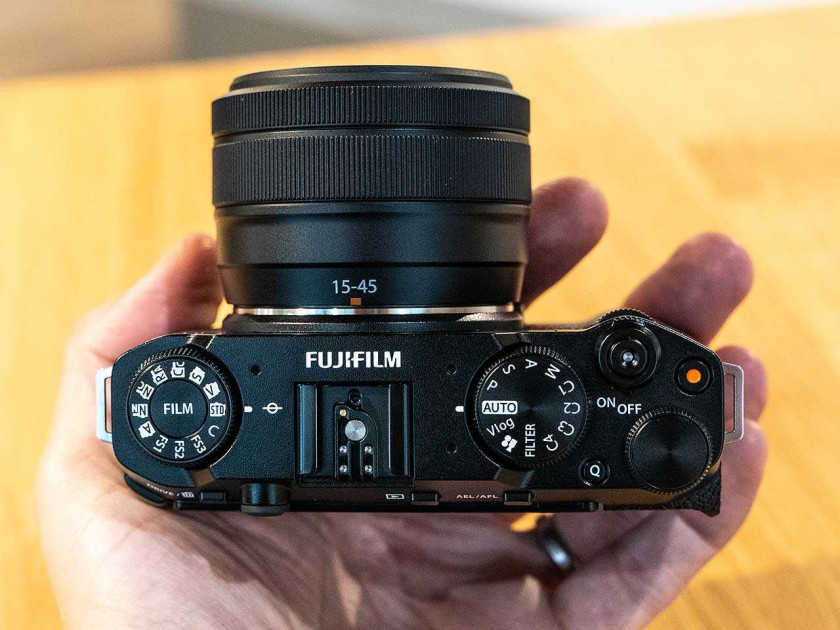
Introduction
The Fujifilm X-M5 is a new entry-level, APS-C sensor, mirrorless camera which was first announced in October 2024 and went on sale in November 2024.
It features the same 26 megapixel X-Trans BSI CMOS 4 sensor and X-Processor 5 processor as the more expensive X-S20 model. It therefore provides exactly the same image quality and auto-focus performance.
It can automatically detect animals, birds, cars, motorcycles, bicycles, airplanes, trains, insects and drones thanks to the X-Processor 5’s AI deep learning capabilities.
There’s a dedicated Film Simulation dial which provides quick access to selected simulations plus three user modes, just like on the X-T50. There are 20 film simulations in total including Reala Ace.
The native sensitivity range is ISO 160 to ISO 12,800, which can be expanded to ISO 80 to ISO 51,200.
It offers 8fps continuous shooting when using the manual shutter, increasing to 20fps when switching to the electronic shutter without any crop, or 30fps with a 1.25x crop applied.
It can record a highest video quality rate of 6.2K/30P Open Gate, plus DCI 4K/60P, 1080/60P, 1080/240P high-speed, in 4:2:2 10-bit internally up to 200Mbps bit-rate.
The brand new 9:16 short movie mode creates a 1080p vertical movie when holding the camera horizontally.
There are 3 internal directional microphones offering surround, front and back priority, plus improved wind filter and steady-state noise reduction modes.
Connection via USB cable to a smartphone is available for the first time via the new Fujifilm XApp for high-speed transfer.
The more powerful digital stabilization mode for video (1.32x crop) can now auto-correct rolling shutter in-camera and there’s a new portrait enhancer mode for both video and stills.
It offers up to 60min recording time at room temperature as standard, with the new 4K Long-play mode applying a bigger crop to help reduce heat and further extend recording times.
For the first time on an X-series camera, all the connection ports are located on the opposite side of the flip-screen, with the microphone jack positioned on top.
The X-M5 is smaller and lighter than the similarly priced X-T30 II entry-level camera, measuring 111.9 x 66.6 x 38.0mm and weighing in at 355g versus 378g for the XT30II.
The Fujifilm X-M5 is available in two different colours – Black or Silver – priced at £799 / €899 / $799 body-only or £899 / €999 / $899 with the XC 15-45mm F3.5-5.6 OIS PZ kit lens. It is manufactured in China.
Ease of Use
Fujifilm are well-known for their traditional approach to design, with the vast majority of their APS-C and medium format models resembling classic cameras from the past.
Aperture rings adorn most lenses, a plethora of dials adorn most camera bodies, and viewfinders are derigeur on all but a handful of models.
So it will perhaps be a surprise to many to see the introduction in late 2024 of the X-M5, the smallest and lightest offering in the now extensive X-series range, and one of the most pared-back in terms of its design.
In order to achieve its diminutive stature, this APS-C model breaks with recent tradition by eschewing a viewfinder, pop-up flash and in-body image stabilisation, three key features that photo enthusiasts usually look for in a Fuji camera.
The new XM5 joins the very short list of X-series models that don’t have a viewfinder, including the original X-M1 from way back in 2013 and the more recent, entry-level X-A20 that’s aimed at complete beginners.
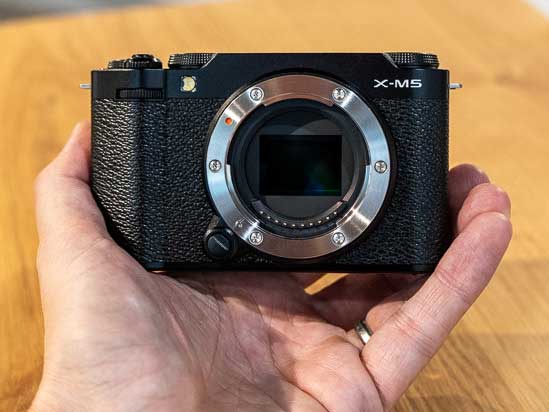 |
This is a “missing” feature that will no doubt alienate a lot of Fuji fans, and indeed anyone who prefer to compose their images by holding the camera up at eye-level. Clearly this isn’t the camera for you, if you fit this description.
But then that’s really missing the point of the X-M5, which is a clear attempt to extend the popularity of Fujifilm cameras to a new audience, namely smartphone upgraders and hybrid content creators, largely by breaking with the Fujifilm traditions.
Those target audiences are far more used to holding their photographic device of choice at arm’s length, whether it be for taking stills and/or recording video, both of which the X-M5 is very proficient at doing.
There are other Fuji models available, including the X-T30 II and X-E4, which have viewfinders and are better suited to the enthusiast photographer that Fujifilm cameras typically appeal to.
In-body image stabilisation (IBIS) is arguably a bigger miss for a camera that will be held at arm’s length and would therefore benefit from some assistance, but incorporating such a unit would have made the X-M5 much larger and heavier.
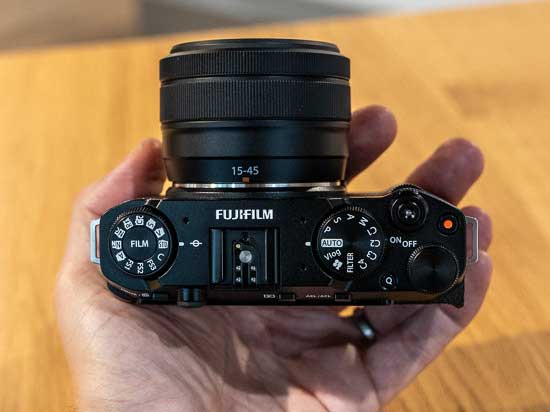 |
Being such a small and lightweight camera helps to offset some of the inevitable jitters, as does the fact that the XC 15-45mm F3.5-5.6 OIS PZ kit lens at least offers 3 stops of CIPA-rated stabilisation.
You’ll need to step up to the X-S20, which features 5-axis in-body image stabilisation, supporting up to a maximum of 7 stops of compensation, making it the joint-best of any current Fujifilm camera with the X-H2 and X-H2S.
The X-M5 is much lighter than the X-S20, though, measuring 111.9 x 66.6 x 38.0mm and weighing in at 355g versus 491g for the X-S20 with a memory card and battery inserted, which is roughly 25% lighter.
The X-S20 does have a viewfinder, IBIS and also a pop-up flash, with the latter being another desirable feature that the X-M5 omits in order to be quite so small.
The two cameras, the X-M1 and X-A20, were both similarly sized and yet still sported built-in flash units, so it’s perhaps surprising that the X-M5 doesn’t follow suit.
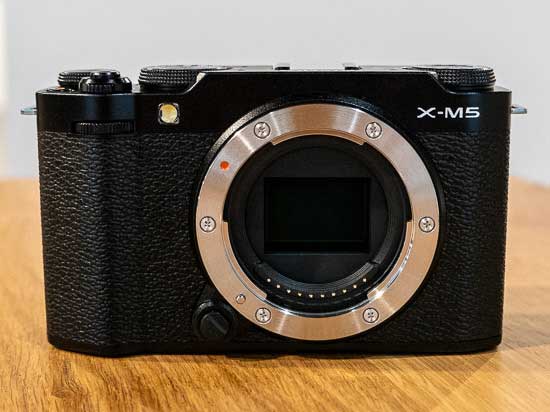 |
The XM5 also has a much smaller hand-grip than the X-S20 – not small enough to be annoyingly useless, but certainly not on a par with its larger sibling.
Both models offer a simpler interface than higher-end Fujifilm camera in order to try and make them more appealing to less experienced users.
The rear of the X-M5 is simpler too, with the traditional D-pad completely disappearing in favour of a more touchscreen-heavy interface.
Importantly the XM5 still offers front and rear command dials, which along with the customisable Function button make it easy to quickly change the shutter speed, aperture and exposure compensation, depending on which shooting mode you’re currently using.
If you’ve ever considered a Fuji camera but been put of by its plethora of manual controls – something that a lot of people love with a passion – then the X-M5 will be more up your street.
 |
This camera has a 3-inch vari-angle LCD screen that can be tilted out to the side and rotated forwards, and also folded against the back of the camera to help protect it when not in use.
For the first time on an X-series camera, all the connection ports on the X-M5 are located on the opposite side of the flip-screen, with the microphone jack positioned on top, so that nothing gets in the way of the screen when it’s folded out.
Fujifilm have given the X-M5 a dedicated Film Simulation dial which provides quick access to selected simulations plus three user modes, just like on the X-T50. There are 20 film simulations in total, including the latest Reala Ace.
This effectively replaces the drive mode dial that is typically found on the left-hand side of the top-plate of the X-S20 and other Fuji cameras. It’s another conscious design decision by Fuji that some users will love and some will dislike, probably with JPEG users falling into the former camp and Raw shooters into the latter.
The image sensor used in the new X-M5 and also the more expensive X-S20 is the same 26.1 megapixel, APS-C sized, X-Trans 4 BSI CMOS sensor, so both models therefore provide exactly the same image quality. The native sensitivity range of both cameras is ISO 160 to ISO 12,800, which can be expanded to ISO 80 to ISO 51,200.
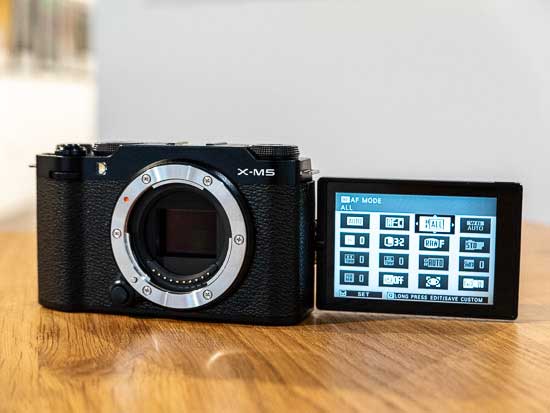 |
Both cameras also benefit from using the latest X-Processor 5 processor, which primarily means that the XM5 is able to offer the same sophisticated auto-focusing and additional 6K video codecs which the XS20 also supports.
The new X-M5 has exactly the same hybrid autofocus system with phase detection and and contrast detections points as the more expensive X-S20.
In the Single point AF mode there are up to 425 selectable AF points arranged in a 25×17 grid. Alternatively, the camera can be set to 117 points in a 13×9 grid, and the size of the points can also be varied.
In addition to Single point AF, there’s Zone AF which allows the AF points to be selected in 3×3, 5×5 or 7×7 groups, and Wide/Tracking AF.
The X-S20 can automatically detect animals, birds, cars, motorcycles, bicycles, airplanes, trains, insects and drones thanks to the X-Processor 5’s AI deep learning capabilities, a feature that it shares with the flagship XH2S and X-H2 models.
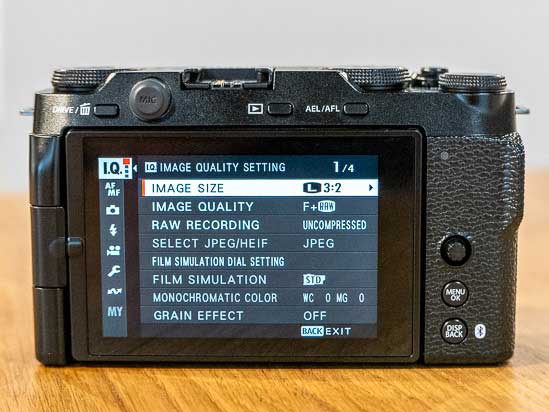 |
Turning to video, the XM5 offers a highest quality rate of 6.2K/30p with a modest 1.23x crop recorded in 4:2:2 10-bit internally.
It also provides up to DCI 4K/60p recording with a 1.17x crop factor and can shoot 1080/240p slow-motion footage. It supports the latest F-Log 2 profile with up to 14+ stops of dynamic range.
The X-M5 offers bit-rates up to 200Mbps and up to 60min recording time at room temperature as standard.
Combined with a compatible HDMI recording device from Atomos or Blackmagic Design, 12-bit RAW video output from the X-M5 can be recorded as Apple ProRes RAW or Blackmagic RAW.
There is a special Vlog shooting mode on this camera for Vlog production. Set the Shooting Mode dial to “Vlog” to quickly change key camera settings with a touch of a button for video self-portraits. It also enables the Product Priority auto-focus mode and Background Defocus option.
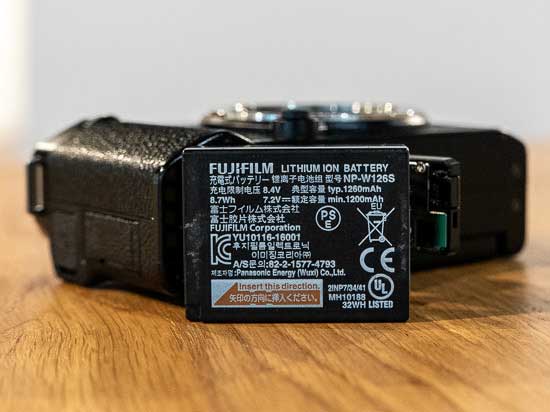 |
Product Priority is a special autofocus mode that alerts the camera to switch focus from a person’s face to an object that may be held up in front of the camera.
This is a popular YouTube technique for when wanting to show an item to the viewer, but on cameras with slower autofocus it can leave the focus fixed on the presenter’s face with the product out of focus, and vice versa. The Product Priority mode solves that issue, adding another plus point for vlogging with the X-M5.
For vloggers, the aim of the Background Defocus option is to quickly switch between having the background blurred or clear. In photographic terms it is switching the aperture between the largest available on the attached lens and a much smaller one. Note that it is only available for video and not also for stills.
It supports the Long GOP and All Intra compression formats, F-Log profile, digital image stabiliser, IS Mode Boost, different Main menu and Quick menu systems for stills and video modes, and 3.5mm MIC and headphone sockets.
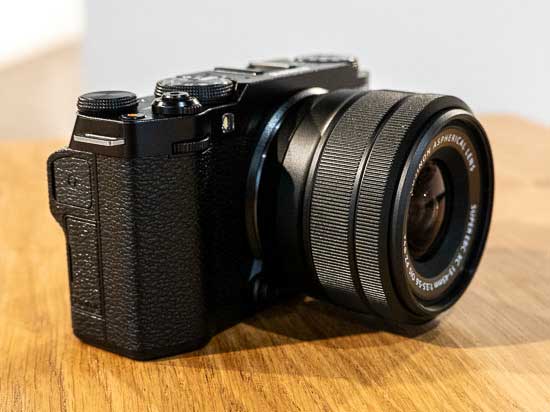 |
The X-M5 does offer a number of new video features that the X-S20 step-up model doesn’t currently have.
The brand new 9:16 short movie mode creates a 1080p vertical movie when holding the camera horizontally.
There are 3 internal directional microphones offering surround, front and back priority, plus improved wind filter and steady-state noise reduction modes.
Connection via USB cable to a smartphone is available for the first time via the new Fujifilm XApp for high-speed transfer.
The more powerful digital stabilization mode for video (1.32x crop) can now auto-correct rolling shutter in-camera and there’s a new portrait enhancer mode for both video and stills.
The new 4K Long-play mode applies a bigger crop to help reduce heat and further extend recording times.
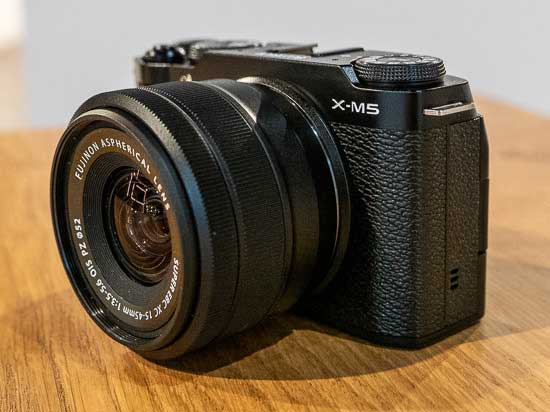 |
The X-M5 offers 8fps continuous shooting speed when using the mechanical shutter. If you switch to the electronic shutter, it can shoot at up to 20fps with no crop or 30fps with a 1.25x crop applied.
It only has a single memory card slot, rather than dual card slots, and it only supports slower UHS-I speed cards.
The memory card slot is next to the battery in a shared compartment on the bottom of the camera, which is not very convenient when the camera is mounted on a tripod.
The more expensive X-S20 uses a higher capacity NP-W235 battery, offering up to 800 shots on a single charge, whereas the X-M5 uses a smaller, lower-capacity NP-W126S battery which only offers up to 330 frames or 440 in Economy mode.
Both cameras can also be powered and charged via the USB-C connection, which is useful if you’re out and about and have a compatible power-bank to plug the camera into.
You can use a USB-Type C cable to connect this camera to a computer to use it as a webcam without having to use any software, unlike older models which have to use the Fujifilm X Webcam app.
Image Quality
All of the sample images in this review were taken using the 26.1 megapixel Raw + Fine JPEG setting, which gives an average image size of around 55Mb and 10Mb respectively.
Noise
There are 11 ISO settings available for the Fujifilm X-M5 for RAW and JPEG files. Here are some 100% crops which show the levels of noise for each ISO setting.
File Quality
The Fujfilm X-M5 shoots in RAW and JPEG with two quality settings, Fine and Normal. Here are some 100% crops of those three options with the file size shown in brackets.
| Fine (13.7Mb) (100% Crop) | Normal (8.37Mb) (100% Crop) |
 |  |
| RAW (55.7Mb) (100% Crop) | |
 |
Dynamic Range
The Fujifilm X-M5 has three dynamic range settings – 100% (on by default), 200%, and 400% – and an Auto setting if you want to let the camera take control.
These settings gradually increase the amount of detail visible in the shadow and highlight areas, with the side-effect of more noise appearing in the image. Note that you can’t actually turn this feature off. All three settings are available from ISO 500 upwards.
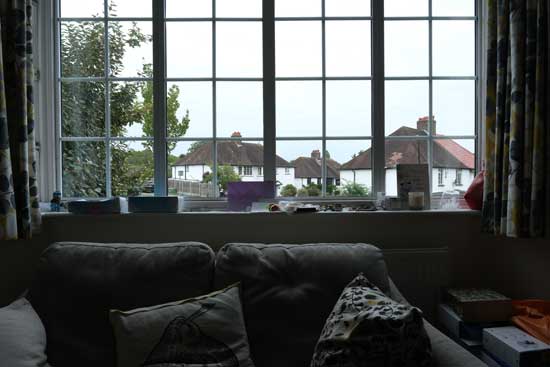 100%
100%
 200%
200%
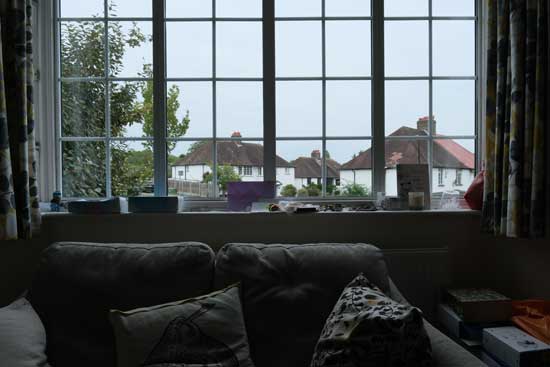 400%
400%
HDR
The Fujifilm X-M5 has a High Dynamic Range mode with five different settings – AUTO, 200%, 400%, 800%, 800%+. The camera takes three shots with different exposures, changing the shutter speed for each one, and then combining them in-camera.
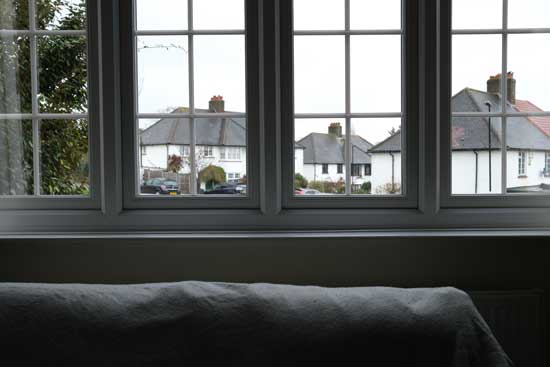 Off
Off
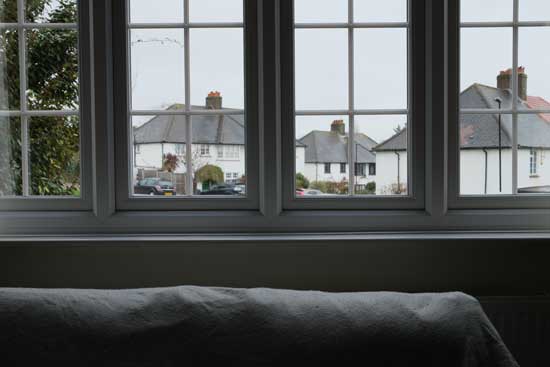 Auto
Auto
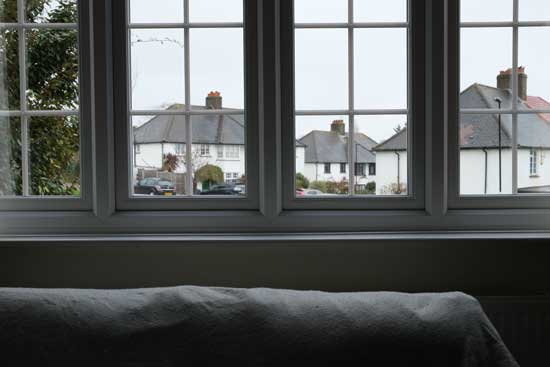 200%
200%
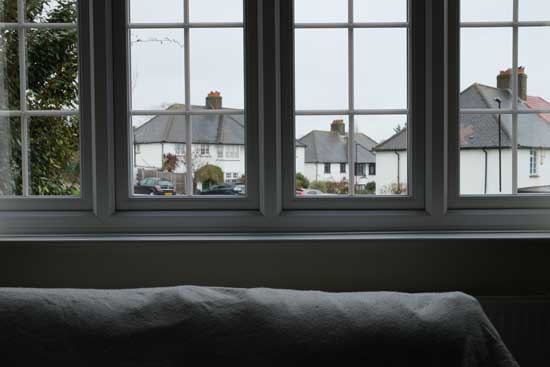 400%
400%
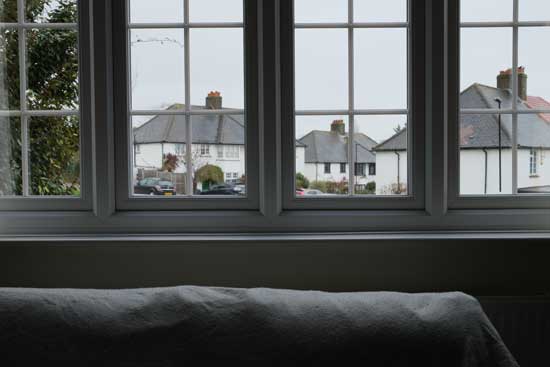 800%
800%
 800+%
800+%
Film Simulations
The Fujifilm X-M5 offers 20 different film simulation modes to help replicate the look of your favourite film stock from the past.
 Provia / Standard
Provia / Standard
 Velvia / Vivid
Velvia / Vivid
 Astia / Soft
Astia / Soft
 Classic Chrome
Classic Chrome
 Reala Ace
Reala Ace
 Pro Neg. Hi
Pro Neg. Hi
 Pro Neg. Standard
Pro Neg. Standard
 Classic Neg.
Classic Neg.
 Nostalgic Neg.
Nostalgic Neg.
 Eterna / Cinema
Eterna / Cinema
 Eterna Bleach Bypass
Eterna Bleach Bypass
 Acros
Acros
 Monochrome
Monochrome
 Sepia
Sepia
Advanced Filters
The Fujifilm X-M5 offers 13 different creative filter effects which are found in the Drive menu.
 Toy Camera
Toy Camera
 Miniature
Miniature
 Pop Color
Pop Color
 High-Key
High-Key
 Low-Key
Low-Key
 Dynamic Tone
Dynamic Tone
 Soft Focus
Soft Focus
 Partial Color (Red)
Partial Color (Red)
 Partial Color (Orange)
Partial Color (Orange)
 Partial Color (Yellow)
Partial Color (Yellow)
 Partial Color (Green)
Partial Color (Green)
 Partial Color (Blue)
Partial Color (Blue)
 Partial Color (Purple)
Partial Color (Purple)
Multiple Exposure
The Fujifilm X-M5’s Multiple Exposure mode combines up to 9 different images together in-camera to create one composite image, with four different ways of combining them – Additive, Average, Bright, Dark.

Sample Images
This is a selection of sample images from the Fujifilm X-M5 camera, which were all taken using the 26 megapixel Fine JPEG setting. The thumbnails below link to the full-sized versions, which have not been altered in any way.
Sample RAW Images
The Fujifilm X-M5 enables users to capture RAW and JPEG format files. We’ve provided some Fujifilm RAW (RAF) samples for you to download (thumbnail images shown below are not 100% representative).
Sample Movies & Video
This is a sample 6K movie at the quality setting of 6240×4160 pixels at 30 frames per second.
This is a sample DCI 4K movie at the quality setting of 4096×2160 pixels at 60 frames per second.
This is a sample 4K movie at the quality setting of 3840×2160 pixels at 60 frames per second.
This is a sample 4K movie at the quality setting of 3840×2160 pixels at 30 frames per second.
This is a sample vertical 1080p movie at the quality setting of 1080×1920 pixels at 30 frames per second.
This is a sample slow-motion 1080p movie at the quality setting of 1920×1080 pixels at 240 frames per second.
Product Images



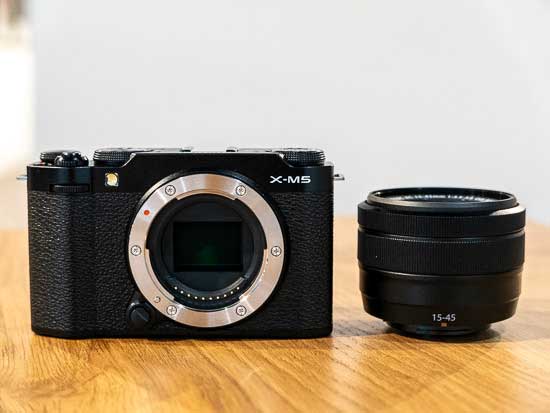
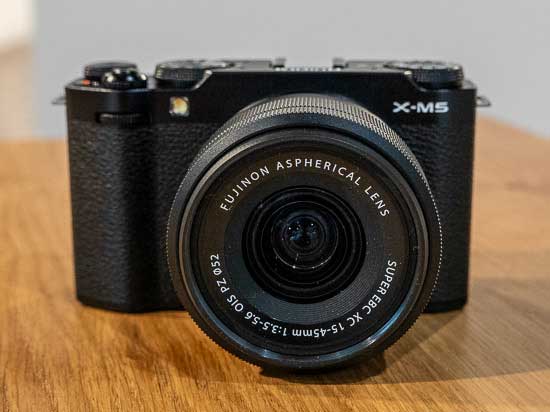
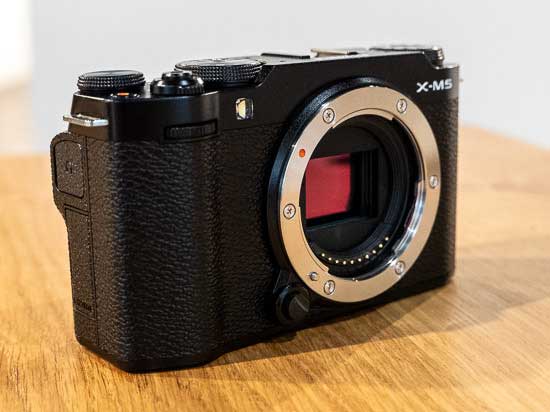

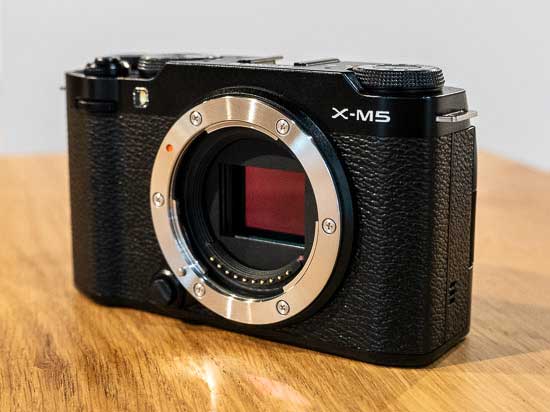

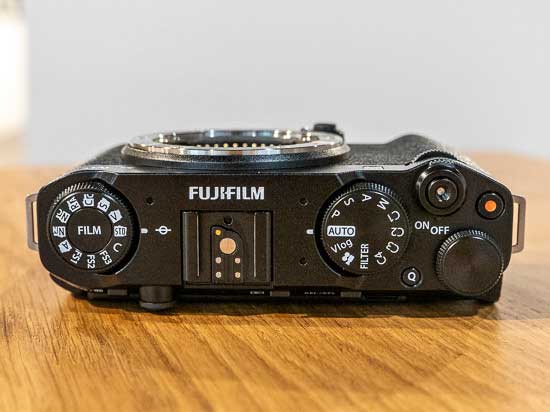
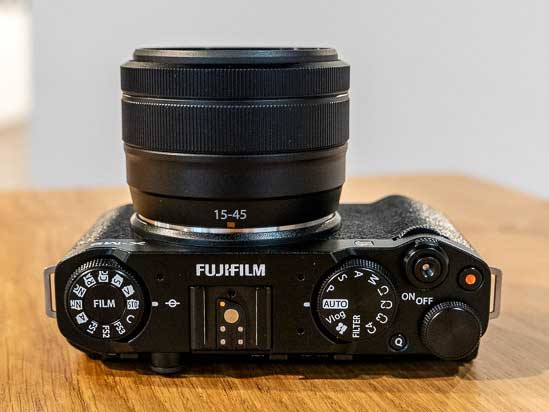
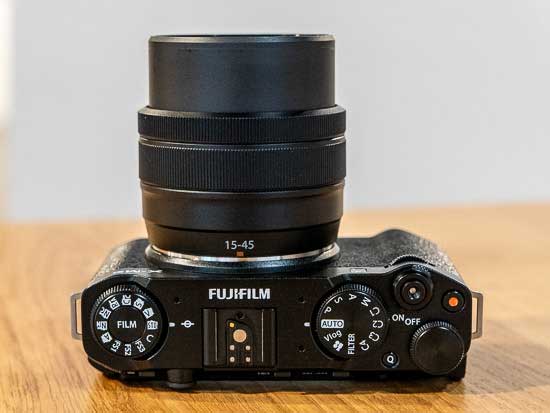

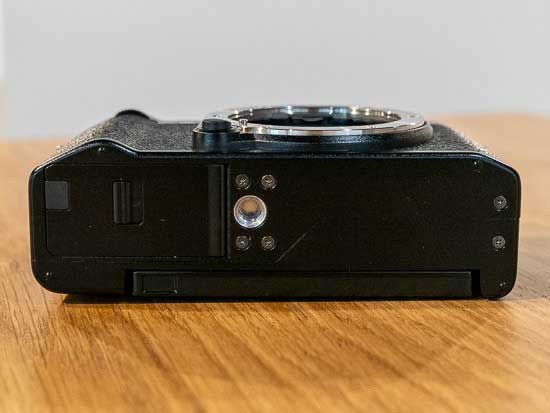
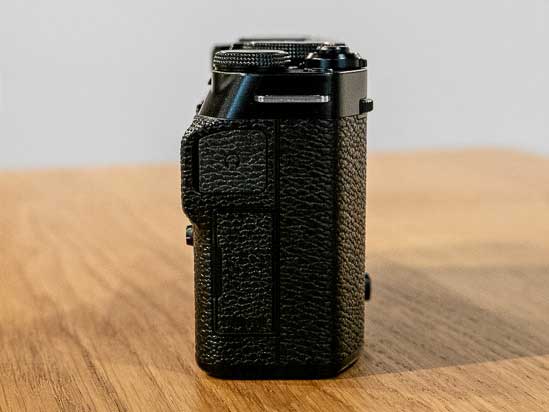
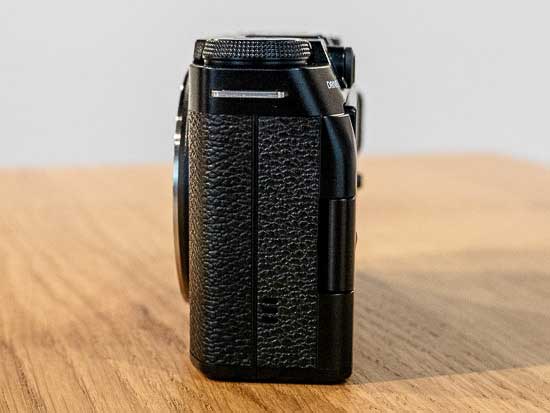
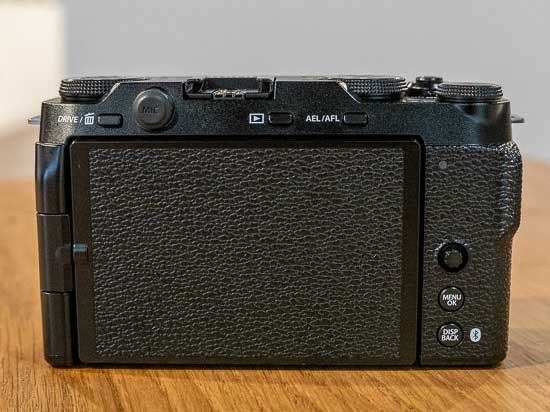

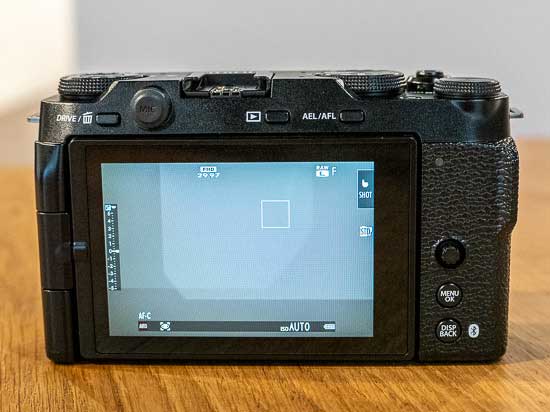

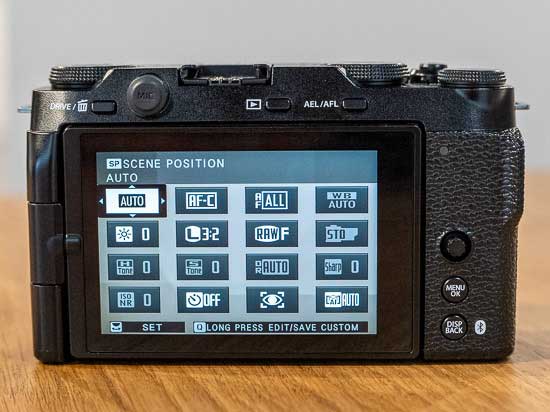


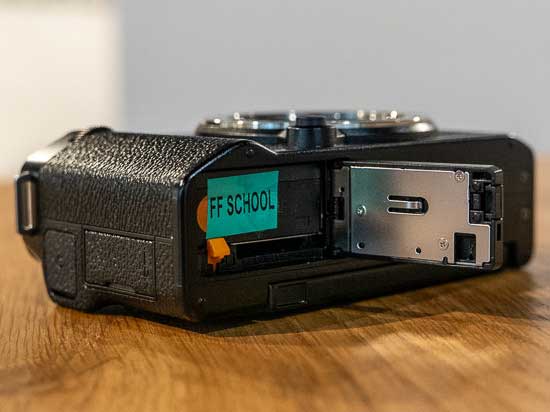

Conclusion
The new X-M5 is the smallest, lightest and cheapest model in the Fuji X-series range of APS-C sensor cameras (as of November 2024).
It’s also a clear attempt to extend Fujifilm’s brand appeal to a wider audience than their traditional market of enthusiast photographers, with smartphone upgraders and hybrid content creators the main focus of attention.
With a wealth of both existing and brand new video features and both microphone and headphone jacks, the X-M5 has a lot to offer the one-person-band videographer, yet it doesn’t forget the stills side of things too, with twin command dials, mechanical shutter, joystick, film simulation dial and the latest AF system on-board.
Sure, some major design omissions have been made in order to make this camera so small, most notably the lack of a viewfinder, in-body stabilisation and a pop-up flash, but they’re all arguably warranted given the target market.
They’re also all “missing” things that will put off the enthusiast photographer that Fujifilm cameras usually appeal to, although the aggressive price tag certainly makes it a tempting proposition as a second, carry-everywhere camera.
Importantly, this camera comes in at less than £$€1000 bundled with the XC 15-45mm PZ kit lens, undercutting its main rival, the Sony ZV-E10 II, and looking very attractively priced on store shelves at just three numerical figures.
Other alternatives include the Nikon Z30, which is even cheaper than the X-M5 but can’t match its video capabilities, and the full-frame Panasonic Lumix S9, which as you’d expect is a lot more expensive.
Overall, the X-M5 is a stylishly retro, impressively small and satisfyingly capable camera that’s predominantly aimed at vloggers, but which doesn’t entirely forget photographers too.
| Ratings (out of 5) | |
|---|---|
| Design | 4 |
| Features | 4 |
| Ease-of-use | 4 |
| Image quality | 5 |
| Value for money | 4 |
Main Rivals
Listed below are some of the rivals of the Fujifilm X-M5.
The Canon EOS R10 is a tiny new mirrorless camera with an APS-C sensor that can shoot at up to 23fps and record 4K/60p video. Can the R10 compete with the likes of the Fujifilm X-S10, Nikon Z50 and Sony A6400? Find out now by reading our in-depth Canon R10 review…

At just £490 / $480, the EOS R100 is the cheapest mirrorless camera in the Canon range, offering 24 megapixels and 4K video recording in a tiny body. Can you really buy a decent camera for such a small amount of money? Find out now by reading our in-depth review of the Canon EOS R100 APS-C mirrorless camera, complete with full-size sample photos and videos.

The Canon EOS R50 is a super-compact mirrorless camera with an APS-C crop sensor that can shoot at 15fps and record 4K/30p video. Can the R50 compete with the likes of the Fujifilm X-S10, Nikon Z30 and Sony ZV-E10? Find out now by reading our in-depth Canon R50 review with full-size sample photos and videos.

After 4 long years of patiently waiting, the Fujifilm X-E4 has finally arrived. Boasting all of Fuji’s latest imaging tech wrapped up in a beautiful classic rangefinder design, could this small, lightweight and very affordable mirrorless camera be the right one for you? Find out now by reading our in-depth Fuji XE4 review, complete with full-size sample photos…

The Fujifilm X-S10 mirrorless camera aims to bring the renowned X-series image quality and colour science to a wider audience by being smaller, easier to use and cheaper than the company’s flagship cameras. Does it strike the right balance between simplicity and accessibility? Find out now by reading our in-depth Fuji XS10 review…

The new Fujifilm X-S20 aims to be a hybrid mirrorless camera for the masses, offering 6K video, 26 megapixel stills, a specific shooting mode for vloggers and long battery life, all in a small, well-built body. Is the XS20 the ultimate do-it-all camera? Find out now by reading our in-depth Fuji XS20 review complete with full-size sample images and videos.

The X-T30 II is the latest mid-range mirrorless camera from Fujifilm, boasting a 26 megapixel APS-C sensor, 4K/30p video recording, 30fps burst shooting and a stylish retro look and feel. Is the replacement for the two-year-old X-T30 worth considering? Find out now by reading our XT30 II review complete with full size sample photos…

The Fujifilm X-T50 is a cheaper alternative to the popular X-T5 that promises to deliver the same image quality in a smaller, lighter body. Can it follow in the successful footsteps of its big brother? Find out now by reading our full Fuji XT50 review…

The new Z30 is Nikon’s third APS-C cropped-sensor mirrorless camera, following in the footsteps of the Z50 and Z fc models. This time around, though, it’s primarily targeted at vloggers and content creators. Find out what it has to offer by reading our in-depth Nikon Z30 review complete with full-size sample photos and videos…

The Olympus PEN camera series is back with the launch of the beautiful new E-P7, but is it a case of style over substance? Read our detailed Olympus PEN E-P7 review complete with full-sized sample photos and videos to find out!

OM System have just updated their enthusiast model for 2022 with the launch of the new OM-5, but is it any good? Find out now by reading our review of the OM System OM5 mirrorless camera, complete with full-size sample photos and videos…

We’ve kicked off our Panasonic Lumix S9 review with sample JPEG and RAW images, product shots and more…

The Sony ZV-E10 II is a mirrorless camera that’s directly aimed at vloggers, with 4K/60p recording, a vari-angle screen, fast auto-focusing, three-capsule direction microphone, and a wealth of vlogger-friendly shooting modes. Is this a good camera for aspiring videographers and social media creators? Read our Sony ZV-E10 II review, complete with full-size photos and videos, to find out…

The Sony ZV-E10 is a new APS-C sensor mirrorless camera that’s clearly targeted at videographers, with a vari-angle screen, fast auto-focusing, three-capsule direction microphone, and a wealth of vlogger-friendly shooting modes. Is this the ultimate mirrorless camera for aspiring YouTube creators? Read our in-depth Sony ZV-E10 review to find out…
Specifications
Model Name
FUJIFILM X-M5
Lens Mount
FUJIFILM X mount
Image Sensor
23.5mm x 15.6mm (APS-C) X-Trans CMOS 4 with primary color filter
Number of effective pixels
26.1 millions pixels
Sensor Cleaning System
Ultra Sonic Vibration
Image Processing Engine
X-Processor 5
Storage media
SD Card (-2GB)
SDHC Card (-32GB) SDXC Card (-2TB) UHS-I *Please see the Fujifilm website (https://fujifilm-x.com/support/compatibility/cameras/) to check memory card compatibility.
File format of still image
DCF
Compliant with Design rule for Camera File system (DCF2.0) JPEG Exif Ver.2.32 HEIF 4:2:2 10bit RAW 14bit RAW (RAF original format) TIFF 8bit / 16bit RGB (In-camera Raw Conversion Only) Notes *Exif 2.32 is a digital camera file format that contains a variety of shooting information for optimal printing
Number of recorded pixels
[L]
3:2: 6240 x 4160
16:9: 6240 x 3512
1:1: 4160 x 4160
[M]
3:2: 4416 x 2944
16:9: 4416 x 2488
1:1: 2944 x 2944
[S]
3:2: 3120 x 2080
16:9: 3120 x 1760
1:1: 2080 x 2080
Panorama
[L]
vertical: 2160 x 9600
horizontal: 9600 x 1440
[M]
vertical: 2160 x 6400
horizontal: 6400 x 1440
Sensitivity
Still Image
Standard Output
AUTO1
AUTO2 AUTO3 ISO160~12800 (1/3 step)
Extended Output
ISO80
ISO100 ISO125 ISO25600 ISO51200
Movie
Standard Output
AUTO
ISO160~12800 (1/3 step)
Extended Output
ISO25600
Exposure control
TTL 256-zone metering
Multi
Spot
Average
Center Weighted
Exposure mode
P (Program AE)
A (Aperture Priority AE)
S (Shutter Speed Priority AE)
M (Manual Exposure)
Exposure compensation
Still
-5.0EV~+5.0EV 1/3EV step Movie -2.0EV~+2.0EV 1/3EV step
Image stabilizer
Digital Image Stabilization
Yes (movie mode only) IS MODE BOOST Yes (movie mode only)
Shutter type
Focal Plane Shutter
Shutter speed
Mechanical Shutter
P mode 30sec. to 1/4000sec.
A mode
30sec. to 1/4000sec.
S/M mode
15min. to 1/4000sec.
Bulb
up to 60min.
Electronic Shutter
P mode 30sec. to 1/32000sec.
A mode
30sec. to 1/32000sec.
S/M mode
15min. to 1/32000sec.
Bulb
1sec. Fixed
Electronic Front Curtain Shutter
P mode 30sec. to 1/4000sec.
A mode
30sec. to 1/4000sec.
S/M mode
15min. to 1/4000sec.
Bulb
up to 60min.
Mechanical + Electronic Shutter
P mode 30sec. to 1/32000sec.
A mode
30sec. to 1/32000sec.
S/M mode
15min. to 1/32000sec.
Bulb
up to 60min.
Notes
*Mechanical shutter works until 1/4000sec.
E-Front + Mechanical Shutter
P mode 30sec. to 1/4000sec.
E-Front + Mechanical + Electronic Shutter
P mode 30sec. to 1/32000sec.
Movie
6.2K 1/4000sec. to 1/24 sec.
4K/DCI4K
1/4000sec. to 1/24 sec.
FHD
1/4000sec. to 1/24 sec.
Notes
*Cannot choose slower shutter speed than framerate for some settings.
Synchronized Shutter Speed For Flash
Mechanical shutter 1/180sec. or slower
Continuous shooting
CH
Electronic ShutterApprox. 30fps (1.25x Crop)
JPEG 128frames Compressed RAW 78frames Lossless compressed RAW 46frames Uncompressed RAW 23frames Compressed RAW + JPEG 32frames Lossless compressed RAW + JPEG 27frames Uncompressed RAW + JPEG 21frames
Electronic ShutterApprox. 20fps (1.25x Crop)
JPEG 141frames Compressed RAW 81frames Lossless compressed RAW 47frames Uncompressed RAW 24frames Compressed RAW + JPEG 46frames Lossless compressed RAW + JPEG 38frames Uncompressed RAW + JPEG 21frames
Electronic ShutterApprox. 10fps (1.25x Crop)
JPEG 204frames Compressed RAW 113frames Lossless compressed RAW 57frames Uncompressed RAW 25frames Compressed RAW + JPEG 66frames Lossless compressed RAW + JPEG 54frames Uncompressed RAW + JPEG 22frames
Electronic ShutterApprox. 20fps
JPEG 127frames Compressed RAW 60frames Lossless compressed RAW 34frames Uncompressed RAW 23frames Compressed RAW + JPEG 34frames Lossless compressed RAW + JPEG 26frames Uncompressed RAW + JPEG 21frames
Electronic ShutterApprox. 10fps
JPEG 155frames Compressed RAW 79frames Lossless compressed RAW 41frames Uncompressed RAW 24frames Compressed RAW + JPEG 48frames Lossless compressed RAW + JPEG 39frames Uncompressed RAW + JPEG 22frames
Electronic ShutterApprox. 8fps
JPEG 173frames Compressed RAW 82frames Lossless compressed RAW 41frames Uncompressed RAW 25frames Compressed RAW + JPEG 52frames Lossless compressed RAW + JPEG 37frames Uncompressed RAW + JPEG 23frames
Mechanical ShutterApprox. 8.0fps
JPEG 173frames Compressed RAW 82frames Lossless compressed RAW 38frames Uncompressed RAW 25frames Compressed RAW + JPEG 52frames Lossless compressed RAW + JPEG 34frames Uncompressed RAW + JPEG 23frames
CL
Mechanical ShutterApprox. 5.0fps
JPEG 1000+frames Compressed RAW 163frames Lossless compressed RAW 48frames Uncompressed RAW 27frames
Mechanical ShutterApprox. 4.0fps
JPEG 1000+frames Compressed RAW 1000+frames Lossless compressed RAW 65frames Uncompressed RAW 28frames
Mechanical ShutterApprox. 3.0fps
JPEG 1000+frames Compressed RAW 1000+frames Lossless compressed RAW 152frames Uncompressed RAW 38frames
Pre-shot
Electronic Shutter, 1.25 X CropApprox. 30fps
30frames 75frames 105frames
Electronic Shutter, 1.25 X CropApprox. 20fps
20frames 576frames 596frames
Electronic Shutter, 1.25 X CropApprox. 10fps
10frames 1000+frames 1000+frames
Electronic Shutter, 1.25 X CropApprox. 20fps
20frames 998frames 1018frames
Electronic Shutter, 1.25 X CropApprox. 10fps
10frames 1000+frames 1000+frames
Electronic Shutter, 1.25 X CropApprox. 8fps
8frames 1000+frames 1000+frames
Notes
*Recordable frames depends on recording media
*Speed of continuous shooting depends on shooting environment and shooting frames
Drive Mode
AE Bracketing
2 frames
3 frames
5 frames
7 frames
9 frames Filmsimulation Bracketing Any 3 types of film simulation selectable Dynamic Range Bracketing 100%
200%
400% ISO Sensitivity Bracketing ±1/3EV
±2/3EV
±1EV White Balance Bracketing ±1
±2
±3 Focus Bracketing AUTO
MANUAL Multiple Exposure Yes (Max. 9 frames)
Additive
Average
Bright
Dark HDR Mode AUTO
2
4
8
800% + Advanced Filter Toy camera
Miniature
Pop color
High-key
Low-key
Dynamic tone
Soft focus
Partial color (Red / Orange / Yellow / Green / Blue / Purple)
Focus
Mode
Single AF
Continuous AF
MF
Type
Intelligent Hybrid AF (TTL contrast AF / TTL phase detection AF)
AF Frame Selection
Single point AF 13×9 / 25×17 (Changeable size of AF frame)
Zone AF
3×3 / 5×5 / 7×7 from 117 areas on 13×9 grid
All
Yes
Subject Detection
Yes (Animal/Bird/Automobile/Motorcycle & Bike/Airplane/Train)
Flash
Shoe Mount Flash
Sync. Mode
1st Curtain
2nd Curtain AUTO FP (HSS)
Flash Mode
TTL (TTL AUTO / STANDARD / SLOW SYNC. )
MANUAL MULTI *When EF-X500 is set OFF
Hot shoe
Yes (Dedicated TTL Flash compatible)
LCD monitor
Aspect Ratio
3:2
Dots
Approx. 1.04 million dots
Touch Screen Mode
Shooting Mode
Shooting
AF Focus Area OFF Double Tap Setting (ON/OFF) Touch Function Setting (ON/OFF) Touch Zoom (ON/OFF)Playback Mode
Swipe
Pinch-in / Pinch-out Double-tap Drag
Movie recording
File Format
MOV
HEVC/H.265, Linear PCM (Stereo sound 24bit / 48KHz sampling)
MPEG-4 AVC/H.264, Linear PCM (Stereo sound 24bit / 48KHz sampling)
MP4
MPEG-4 AVC/H.264, AAC
Movie Compression
6.2K(3:2)
File size 6240 x 4160
Frame rate
29.97p
25p
24p
23.98p
Bitrate
200Mbps
100Mbps
50Mbps
25Mbps
8Mbps
DCI4K(17:9)
File size 4096 x 2160
Frame rate
59.94p
50p
29.97p
25p
24p
23.98p
Bitrate
200Mbps
100Mbps
50Mbps
25Mbps
8Mbps
4K(16:9)
File size 3840 x 2160
Frame rate
59.94p
50p
29.97p
25p
24p
23.98p
Bitrate
200Mbps
100Mbps
50Mbps
25Mbps
8Mbps
Full HD(17:9)
File size 2048 x 1080
Frame rate
59.94p
50p
29.97p
25p
24p
23.98p
Bitrate
200Mbps
100Mbps
50Mbps
25Mbps
8Mbps
Full HD(16:9)
File size 1920 x 1080
Frame rate
59.94p
50p
29.97p
25p
24p
23.98p
Bitrate
200Mbps
100Mbps
50Mbps
25Mbps
8Mbps
Full HDLP(16:9)
File size 1920 x 1080 (1.29x Crop)
Frame rate
59.94p
50p
Bitrate
200Mbps
100Mbps
50Mbps
25Mbps
8Mbps
Full HD(17:9) High Speed Rec.
File size 2048 x 1080
Frame rate
240p
200p
120p
100p
Bitrate
200Mbps (recording)
Full HD(16:9) High Speed Rec.
File size 1920 x 1080
Frame rate
240p
200p
120p
100p
Bitrate
200Mbps (recording)
Microphone Direction Setting
SURROUND, FRONT PRIORITY, BACK PRIORITY, FRONT & BACK PRIORITY
Vlog Mode
Yes
AUTO Mode Setting
AUTO
Portrait
Portrait Enhancer
Landscape
Sport
Night
Night (Tripod)
Fireworks
Sunset
Snow
Beach
Underwater
Party
Flower
Text
Film simulation mode
20 modes
PROVIA/Standard Velvia/Vivid ASTIA/Soft Classic Chrome REALA ACE PRO Neg.Hi PRO Neg.Std Classic Neg. Nostalgic Neg. ETERNA/Cinema ETERNA BLEACH BYPASS ACROS ACROS + Ye Filter ACROS + R Filter ACROS + G Filter Black & White Black & White + Ye Filter Black & White + R Filter Black & White + G Filter Sepia
Monochromatic Color
Yes
Grain Effect
Roughness
STRONG, WEAK, OFF Size LARGE, SMALL
Color Chrome Effect
STRONG, WEAK, OFF
Color chrome Blue
STRONG, WEAK, OFF
Portrait Enhancer Lv
STRONG, MEDIUM, WEAK, OFF
Dynamic range setting
Still
Still AUTO / 100% / 200% / 400%
ISO restriction
DR100%: No limit、DR200%: ISO320 or more、DR400%: ISO640 or more
Movie
Movie 100% / 200% / 400%
ISO restriction
DR100%: No limit、DR200%: ISO320 or more、DR400%: ISO640 or more
White balance
Auto
White Priority
Auto
Ambience Priority
Custom
Custom1 – 3
Color Temperature Selection
2500K~10000K
Preset
Daylight
Shade
Fluorescent Light-1
Fluorescent Light-2
Fluorescent Light-3
Incandescent Light
Underwater
Clarity setting
±5 steps
Self-timer
Still
10sec.
2sec. Movie 10sec.
5sec.
3sec.
Interval timer shooting
Yes (Setting : Interval, Number of shots, Starting time, Interval timer shooting exposure smoothing, Interval priority mode)
Wireless transmitter
Standard
IEEE802.11b/g/n/ (standard wireless protocol) Encryption WPA/WPA2 mixed mode, WPA3 Access Mode Infrastructure
Bluetooth®
Standartd
Bluetooth Ver. 5.2 (Bluetooth low energy) Operating Frequency (Center Frequency) 2402〜2480MHz
Terminal
Digital Interface
USB Type-C USB 10Gbps HDMI Output HDMI Micro connector (Type D) Others ø3.5mm, stereo mini connector (Microphone)
ø3.5mm, stereo mini connector (Headphone)
Hot shoe
Power supply
NP-W126S Li-ion battery (included)
Battery Life For Still Images
Economy Mode Approx. 440 frames
Normal Mode
Approx. 330 frames
Notes
*When XF35mmF1.4 R is set
Actual Battery Life Of Movie Capture
6.2K Approx. 45min. (29.97p)
4K
Approx. 50min. (29.97p)
Full HD
Approx. 45min. (59.94p)、Approx. 50min. (120P)
Notes
*Face detection is set to OFF
Continuance Battery Life Of Movie Capture
6.2K Approx. 65min. (29.97p)
4K
Approx. 85min. (29.97p)
Full HD
Approx. 80min. (59.94p)
Notes
*Face detection is set to OFF
*Approximate number of frames or movie recording time that can be taken with a fully-charged based on CIPA Standard.
Weight
Including Battery And Memory Card
Approx. 355g Excluding Battery And Memory Card Approx. 307g
Operation Environment
Operating Temperature
0℃~+40℃ Operating Humidity 10%~80% (no condensation)
Accessories included
Li-ion battery NP-W126S
Shoulder strap
Body cap
Cooling fan connector cover
Your Comments
Credit : Source Post






